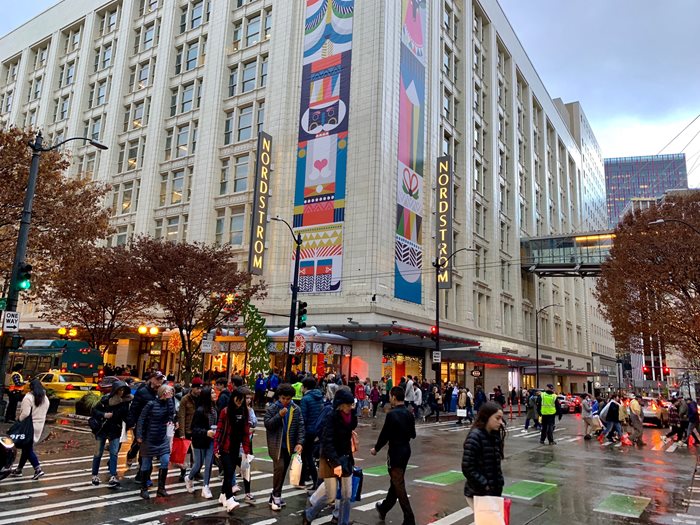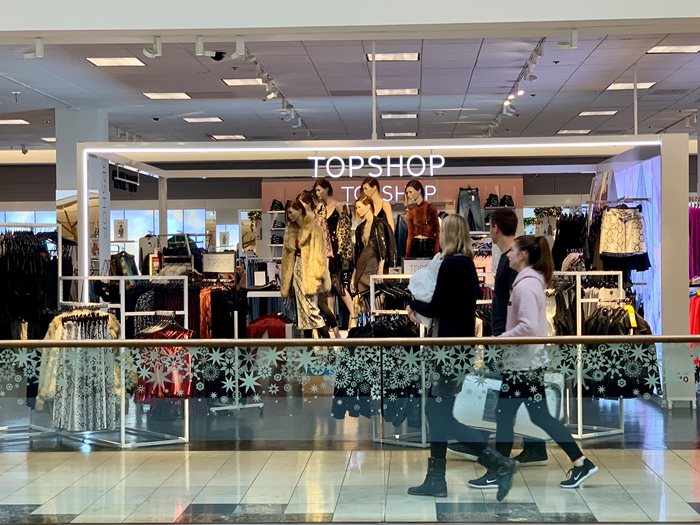The ranking techniques used in Bing Ads can help fashion retailers display beautiful product ads in a cost-effective way which may also be more relevant for shoppers. By working with the American fashion retailer, Nordstrom, these techniques provided a 5.9% increase in Nordstrom's click through rates (number of times a product is clicked over the number of times it is shown).
These techniques can be extended beyond basic ad serving into other scenarios on a fashion retailer’s website. When shoppers use the search box on the fashion retailer’s website, these techniques can improve product search result relevance. Moreover, search results can be tailored to an individual shopper’s fashion taste by integrating additional permissioned signals such as individual purchase behaviors and search history. These signals can also be used in product recommendations to rank products by default if the search query box is not used.
Scenario: Maximize product ad relevance and clicks on Bing Ads
In search advertising, keywords specified by the advertiser are traditionally matched with the query and product description to rank relevant product ads.
However, in the fashion industry, it is costly for advertisers to manually specify and bid on all possible fashion attribute keywords. Since an advertiser’s keywords determine how product ads are ranked, the potential to maximize relevance and thus user clicks are limited by the selection of those keywords.
For example, Nordstrom is an American fashion retailer with 380 stores in the United States and Canada selling clothing, cosmetics, jewelry etc. from various fashion brands.

Nordstrom advertises its products with Bing Ads and bids on keywords such as the names of fashion brands they carry, or the clothing category names. When a Bing user issues the query "topshop dresses on sale", the advertiser’s initially specified keywords "topshop" and "dresses" will match a huge number of potentially relevant dresses from Topshop.

However, dress descriptions may contain many other fashion attribute words like “floral”, “jacquard” or “bodycon” that could closely correlate with the relevance of a given product to the query but were neither specified by the advertiser nor typed in the query by the user. Therefore, it is difficult to identify and properly rank the few most relevant dresses that most users will like, just based on the advertiser’s initial keywords.


Solution: Ranking beyond keyword-based matching
Traditionally, ads were ranked based on keyword matches between the search query and ad description (e.g. "topshop" and "dresses"). Now, Bing can rank product ads based on other words in the product description that did not appear in the query (e.g. "floral", “jacquard”, “bodycon”) or in the initial set of advertiser’s provided keywords.
Since each product description’s relevance is ranked in relation to a user’s query, we consider each Query-ProductDescription to determine the best ordering. This Query-ProductDescription concept is what we refer to as the basic ranking unit. Query-ProductDescription examples for the query “topshop dresses on sale” are shown in Figure 3 below. Unmatched words in each new Query-ProductDescription are colored red. 
How Ranking Works: Learning unmatched word importance from clicks
For a given query, the importance of unmatched words in a product’s description can be learned from other products that were clicked in the past for this query, and that contain the same unmatched words. Specifically, Click Through Rate (CTR) captures how much the user likes a product. For example, given a past identical query “topshop dresses on sale”, if the product “topshop jacquard midi dress” has higher CTR than another product “topshop bodycon midi dress”, you can infer that the unmatched product word “jacquard” is likely more important than “bodycon”. Importance in this case refers to popularity. “Jacquard” refers to dresses with an intricately woven pattern while “bodycon” refers to tight fitting, figure hugging dresses. Feels like jacquard dresses are comfortable hence more popular than bodycon!

To extend the amount of data that can be used to find additional important words, you don’t have to limit yourself to identical queries issued in the past (“topshop dresses on sale”). You can also look at past queries that were similar such as “topshop dresses online” that contains the same query keyword “dresses”.
To enable learning from such similar queries, the query keywords (“dresses”) that co-occur with unmatched product description words are represented as Query-Product word pairs like “dresses-jacquard”, “dresses-bodycon”, etc. Query-Product word pairs are then used as features to represent the original Query-ProductDescription strings.

Once the Query-Product word pairs and CTR data are prepared, they are fed as training data to a machine learning model to learn Query-Product CTR patterns.

When the system is deployed, and a user enters a previously unseen query, the model will generate corresponding Query-Product word pair features for the query and product descriptions from the fashion advertiser’s catalogue. It will then use them to predict the CTR for each product. Products with highest predicted CTR will be ranked highest.

In summary, product ads are ranked based on descending order of predicted CTR to maximize ad relevance and user clicks for the query. This avoids the hassle of fashion advertisers having to specify all keywords manually. Interestingly, using this technique of CTR prediction, fashion retailers can also evaluate the importance of the query ad keywords they entered initially for bidding.
Additional Ranking Considerations: Product Price and Images
You may be thinking that product description words cannot be the only factor that influence a shopper’s browsing and buying behavior. And you would be right - Bing goes beyond ranking strictly based on product descriptions. Other attributes that further advance the relevance of product ads ranking include product prices provided by the advertisers, numerical features like the product’s display price and percentage discounts, or even raw product image pixels are also used together with product description features to represent each product and contribute to ranking.
Fashion Retailer Website Scenarios
The techniques would also apply if a fashion retailer wanted to implement product search on their own website. These fashion retailer website scenarios enable more relevant product search experiences to shoppers, increasing user satisfaction and click through rates.
Presented ranking techniques can similarly be used to maximize the relevance of product search results for shoppers who simply browse for products using the search box. As with the previously described techniques, they are effective even if the query entered by the user does not perfectly match the product description. Product search results would also in this case be ranked by predicted CTR with the same Query-ProductDescription.
Because individual fashion tastes are subjective, as a retailer or an advertiser you may want to improve product relevance further by tailoring it to individual shoppers. Building upon the general search use case, you can extend this technique to support relevant and tailored search experiences. If you have obtained a user’s permission to use their search history of products purchased or browsed, you can append the shopper’s individual context as the third component to the Query-Product ranking unit. The new basic unit of ranking would now become a Query-Product-IndividualContext triplet. Individual context information that can influence a shopper’s behavior could include descriptions of past products browsed and bought by a given shopper.

In yet another scenario, when a shopper first lands on the website’s product catalogue page without using the search query box, fashion retailers can also tailor the default ranked list of recommended products. To achieve this, the ranking unit is modified by removing the Query component so that the fundamental unit of ranking becomes the Product-IndividualContext pair.
Conclusion
We are hard at work on making the user’s experience even better. One of the future directions includes customizing ranking to fit consumer behaviors that are unique to the fashion industry. For example, fashion retailers may want to combine the importance of past clicks to given products with seasonal fashion trends, and individual shopper’s evolving fashion tastes to even better predict future behavior.
The greater vision is to help fashion retailers large or small to showcase fashion in a way that is cost effective and beautifully relevant for each shopper. For more details on this ranking technique’s context, you can refer to Microsoft’s patent titled “Intelligent tabular big data presentation in search environment”.
Acknowledgement: Jay Abraham
This project is advised by an American businessman and marketing consultant named Jay Abraham, founder and CEO of the Jay Abraham Group. Jay uncovers underutilized relationships, underperforming activities, and hidden assets among businesses for marketing and strategic partnerships--making about $2 billion for himself and over 10,000 clients in 400 industries worldwide.

Jay's body of work is instrumental in designing the business model for a new type of strategic partnership around big data like Nordstrom's product catalogue for intelligent fashion retail product search at Microsoft's Bing. An increasing number of enterprises like Nordstrom want to monetize their big data by opening up public access via an interface known as the Application Programmable Interface (API).

The challenge for enterprises owning commercial data like Nordstrom's product catalogue is that their data have limited discoverability on the Internet. Hence, monetization is not maximized. On the other hand, Bing users are searching for queries with shopping intent or looking for discounts/coupons. The greater opportunity is to marry the supply of such permissioned commercial data from Microsoft's enterprise partners with the demand for such data expressed as Bing queries.
ChunMing Chin
www.linkedin.com/in/chunmingchin
Technical Program Manager
On behalf of the Bing Ads, Search and Artificial Intelligence (AI) teams
